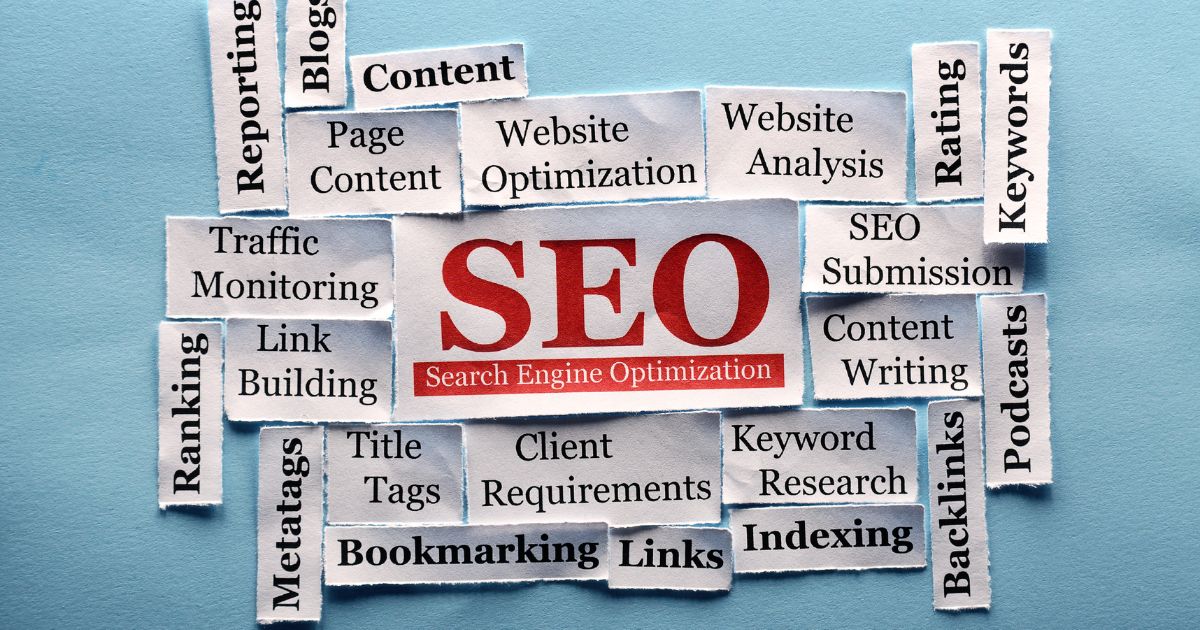SEO content strategy framework: a proven plan for traffic, trust & leads

What is an SEO content strategy?
An SEO content strategy optimizes content to attract organic search on Google, improve search visibility, and meet user intent.
To succeed at content marketing, blog posts and landing pages target specific keywords that rank on the first page of search results. Content strategy for SEO isn’t just writing about generic related terms.
Content marketing supports various marketing goals, builds brand awareness, and engages audiences. You can also diversify through social media content and storytelling (videos and podcasts). It’s not on Google, but you’re building awareness across multiple platforms.
Using this strategy, along with off-page SEO, helps achieve your goal as a content provider. Aside from traffic, it sustains your long-term visibility and improves user engagement.
Why businesses need a strong SEO content strategy
According to Statista, revenue from content marketing reached $72 billion in 2023. With how fast businesses are adapting digitally, we could expect that this number will grow exponentially in the next several years.
So yes, a strong SEO content strategy is essential in achieving one’s business goals. Here are some reasons why you must have an effective strategy:
- Organic growth and compounding results over time. Ensuring a strong SEO content strategy adds good value to your business. Instead of having multiple paid ads that eventually stop after your budget runs out, well-optimized content continuously attracts organic traffic that compounds over time.
- Role of E‑E‑A‑T and Google’s focus on trustworthiness. According to Google, they prioritize websites that show Experience, Expertise, Authoritativeness, and Trustworthiness (E-E-A-T). A strong content strategy sees to it that these standards are met and would address the users’ pain points.
- Targeting the right audience and funnel stage drives conversions. The majority of people have their mobile devices, which makes it easier to type on search engines whenever they need to. An effective SEO strategy would help you reach your right target audience and guide you through every stage of the marketing funnel. Awareness and consideration boost engagement metrics that drive the conversion you need.
- Strategy as a long-term growth framework, not a short-term fix. When you need help in content marketing with the changing search landscape today, Fortis Media can guide you every step of the way. Our focus on building sustainable growth can support your business not just for days or weeks, but for years. We know how to craft an effective enterprise SEO strategy, or a momentum-builder for new websites.

Key elements of an SEO content strategy
If you are still thinking about how to future-proof your SEO content strategy, take note of these key elements and the tools that you can use. Some of these tools are free and paid; we recommend starting with free tools, especially for new websites.
| Key Elements | Description | Tools |
| Keyword research and mapping | Helps you identify and organize main keywords into a logical content structure. A good keyword tool can also provide queries that your competitors rank for. | Semrush, Ahrefs, KWFinder, Google Keyword Planner |
| Topic clustering for authority | Organizes keywords into clusters, boosting topic relevance and search engine optimization performance.
For instance, when doing SEO for crypto, you can have this broader pillar page about “Crypto Wallet Security”. Then, you can cluster more pages around specific keywords like hardware wallets, cold storage setup, phishing scams, and recovering compromised wallets. | Keyword Insights, SEOZoom, HubSpot Topic Clusters |
| Search intent alignment | Ensures content is aligned with the intention of people when they search for something on Google.
Addressing current trends can provide more organic traffic, especially in high-demand industries like crypto, finance, and technology. That’s why doing keyword research isn’t a one-off setup. | Surfer SEO, MarketMuse, manual SERP analysis |
| Competitive content analysis | Tracks multiple pages by competitors to identify gaps, threats, and opportunities.
Are your competitors ranking high on broader keywords? No worries, you can target long-tail keywords that they haven’t written about. | Ahrefs Site Explorer, Semrush Domain Overview, SpyFu |
| Editorial calendar planning | Manages schedules, content calendar, and team collaboration.
Plan your content ahead of time, especially for holiday traffic surges. However, you should still be flexible in inserting unplanned content due to current trends in your space. | Trello, Asana, Notion, Google Sheets, CoSchedule |
An effective SEO content strategy is more than just keyword stuffing blog posts for content’s sake. Instead, it is designed to attract, engage, and convert your target audience through keyword optimization and search visibility.
How to build an effective SEO content strategy
To help you optimize your SEO strategy and gain organic growth over time, here is a step-by-step guide on building an effective SEO content strategy.
1. Audit existing content
Are you worried that your vast, existing content library will go to waste? That’s a valid concern. After all, you’ve spent countless hours researching and writing these pages.
But don’t worry, you can still optimize your old content. And in numerous cases, repurpose them to better-performing formats.
Start by reviewing all existing content and evaluating its performance and user engagement. Using SEO tools like Google Analytics and SEMrush will help you identify what’s driving traffic and which content is underperforming.
Decide which content to keep, update, or remove based on quality and relevance. This is also where you can address content gaps and missed opportunities you found in your audit. This helps future-proof your content and streamlines how you strategize content next time.
2. Define goals and audience
Set clear and measurable key performance indicators (KPIs). You can focus on traffic, leads, and keyword rankings in measuring the success of business outcomes.
You also need to develop audience personas to further understand their search behavior. This SEO strategy could help search engines understand what they are looking for and give you an idea of your next possible content.
Be detailed and imaginative in developing personas. Put yourself in the shoes of your readers, and ask questions like these:
- What do I do for a living, and where am I located?
- What are the most immediate pain points that I want answers to from Google?
- Am I aiming only to get information, or am I willing to spend money to get the product or service that I need?
3. Build keyword/topic clusters
Keyword research is a vital part of this strategy. In identifying your target keywords, you must focus on their relevance and intent.
Highly competitive keywords can be considered, but ensure that they align with what the users are searching for. Some users search for lesser-known keywords, something that you should focus on.
Once you’ve identified your target keywords, group them into topic clusters. Each cluster should center around a core topic, supported by related subtopics. This way, you’ll find it easy to internally link to relevant pages.
Having structured internal links with these topics boost topical authority and helps improve engagement metrics, including session duration and bounce rate.

4. Plan content formats and types
Plan and create content of various types. Users have different intentions when searching on Google; thus, it is important to choose formats based on user intent.
You may deliver up-to-date information through content like blog posts, videos, or infographics that align with specific stages in your customers’ journey.
Don’t be afraid of experimenting with which format works best for your audience.
5. Leverage AI as a supporting tool
AI is making its presence known; there’s no doubt about that.
Even in Google, you can now see the AI overview section when you search for something, right? There are AI-driven searches, and there are AI-generated answers as well.
This could lead to questions like, “Will AI replace writers? Or content creators? But instead of looking at it as a threat, we should start leveraging AI as a supporting tool in many human activities.
AI tools can significantly improve the efficiency and accuracy of content strategy. You can use platforms like Surfer SEO or Clearscope to help you produce top-ranking content and identify keyword gaps. There are others, some are paid tools, that could help summarize long-form content, create content briefs, and provide optimization tips.
However, final touches of your content must remain human-led. AI boosts efficiency, but human expertise ensures relevance and trust among the customers.
6. Optimize for SEO and user experience
One good SEO strategy is to apply on-page SEO best practices. This includes placing headings, image alt text, internal links, and semantic terms to support topic depth. Also, user experience is just as critical. You have to ensure that the content is skimmable and mobile-friendly.
Include meta descriptions, page titles, and meta tags. Including SERP features like featured snippets to boost visibility is a plus as well. Optimizing SEO content helps not just in visibility but in conversions, too.
7. Track, analyze, and iterate
Your job doesn’t end after hitting the Publish button. Use tools like Google Search Console to track your performance.
Knowing the search volume of your content would be useful as well. This could help you analyze if you have achieved your business objectives, or if there are things that need improvement.
With many web pages and other sites that could come up upon searching queries, refreshing and repurposing underperforming pages is the way to go. Continuous optimization keeps your strategy relevant and effective over time.
Common mistakes to avoid
For starters, things may get too overwhelming. There might even come a time when you think your efforts aren’t producing results. The reality is, you can’t perfect your SEO strategy in one night. Search algorithms don’t work that way.
There are bumps along the way, but we’ve got you. Here are some common mistakes that you must avoid in your SEO content strategy:
- Writing without understanding search intent. One common mistake is focusing only on keywords, like primary keywords or long tail keywords. These are important, yes. But you must understand the reason why the user is searching for these keywords. Do they just want information, or is there a real demand for your product or service? Ignoring intent may result in low engagement and poor rankings.
- Ignoring technical SEO basics. High-quality content can fail if you overlook the basics. Broken links or improper URL structure may prevent your content from being ranked. Failure to put up structured data can also affect your visibility. Without technical SEO, your strategy may lack the foundation it needs for long-term organic performance.
- Failing to update or repurpose content. Old content can quickly become outdated in how people consume content today. Failing to refresh content can affect your rankings. Also, not repurposing your content can limit your reach.
- Misaligning topics with funnel stages. Your content must be strategic enough to match the customer journey of your target audience. Misalignment leads to missed conversions and poor user experience. An effective SEO content strategy has a clear purpose at every stage of the funnel.
Real results: how we build winning content strategies
In a highly competitive market like iGaming, the TwinSpires company recognized that they needed more than just any other digital marketing tactics. They realized that they needed a full SEO partner who doesn’t just create content, but integrates it with SEO and PR into a cohesive growth engine. Fortis Media provided exactly what they are looking for.
We became part of and worked as an extension of TwinSpires. We conducted regular weekly alignment meetings, KPI tracking, and strategic adjustments that showed their commitment to the partnership created.
We also anticipate events and seasonality in strategy. We recognize the high-stakes nature of events like the Kentucky Derby. We were able to build the right momentum in advance that resulted in success.
If you need a partner that has a data-driven process, a full-funnel strategy, focuses on E-E-A-T, and measurable ROI, Fortis Media is the answer. If your business aims for sustainable visibility and conversions, seek a partnership with us. With Fortis Media, you will get a strategic growth engine built for the long run.
Final thoughts: from strategy to success
A good SEO content strategy is a must-have for organic growth and sustainability. Do not waste high-quality content without fully optimizing it. Local SEO and referrals from third-party sites may give you a good number, but having an effective content strategy can provide you with the best results.
Moreover, don’t hesitate to ride the technology wave. AI systems can help you research keywords. LLM SEO services improve your visibility on conversational and voice search.
Your strategy won’t be perfect, but avoiding common mistakes in your SEO content strategy won’t hurt, either. To further help you build the SEO content strategy you need, Fortis Media can be your partner. The commitment we have to provide meaningful business outcomes drives us to turn all strategies into success.
FAQ
Can AI tools create a full content strategy for me?
AI tools can provide a content outline, but you still need human expertise to develop a full-blown content strategy. In today’s digitized generation, AI tools are definitely helpful. While it can generate almost everything that we prompted it to do, it still cannot replace human creativity and strategy.
How long does it take to see results from an SEO content strategy?
It typically takes 3-6 months to see initial results, with more significant improvements appearing after 6-12 months. However, this timeline might vary depending on the competition and demand in your industry, along with the scope of your SEO content strategy.
Should I update old blog posts or start fresh?
Old outdated blog posts can be repurposed into better-performing formats. You can repurpose long-form articles into videos or infographics, or optimize the keywords in your existing content. You can add internal links to your old pages, or do on-page strategies like optimizing images.
What KPIs should I track?
Increasing the business value of your content requires tracking Key Performance Indicators (KPIs) such as organic traffic, conversion rate, click-through rate, and keyword ranking. These metrics help gauge how effective your content is in attracting audiences and converting them to customers or clients.
Read our other articles

Top ChatGPT ranking factors in 2025: Everything brands need to know


Crypto content marketing agency: role, benefits, and how to choose a partner that delivers


LLM SEO strategies 2025: practical tips to optimize for AI-powered search results






